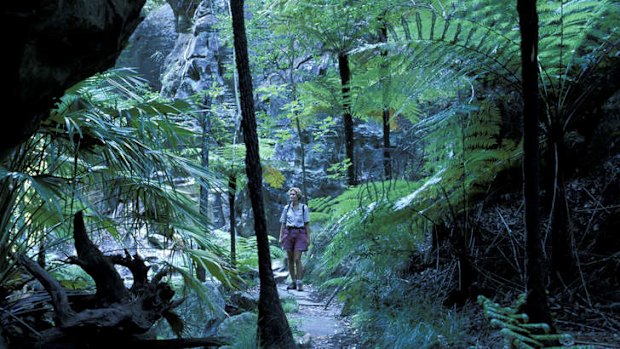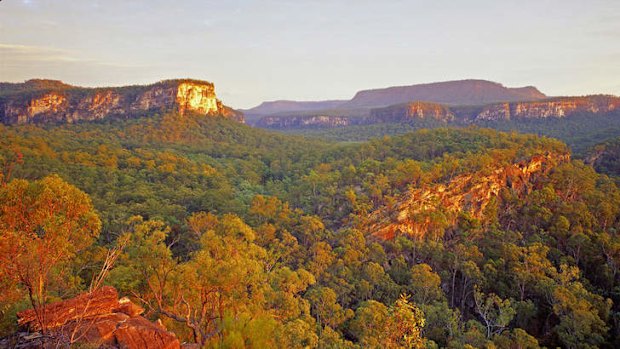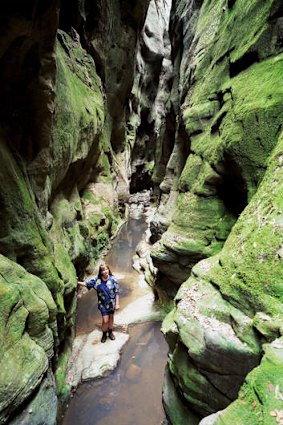
True colours: the rainforest of Carnarvon Gorge.Credit: Alamy
Candida Baker soaks in the spectacular flora, fauna and rock art of Carnarvon Gorge.
In all my years in Australia, the closest I'd been to Carnarvon Gorge, hidden in the rugged ranges of Queensland's central highlands, was Roma, where I'd spent my 21st birthday looking unsuccessfully for a phone booth to "phone home" to Britain. These days, Roma is about the last spot - apart from the small town of Injune - where you can get mobile reception before you face the last narrow 150 kilometres of road, liberally peppered with mining trucks, and the final 22 kilometres of dirt that take you into the gorge.
In the final stage of our 12-hour drive, we encounter a mob of emus grazing on the sunlit plateau surrounded by massive sandstone cliffs. We wend our way across the flat, brown landscape, with its cattle grids and creek crossings, before descending into one of the most varied and verdant landscapes in Australia, home to some of the country's most important and accessible Aboriginal rock art.

Rich tones in the national park.Credit: Getty Images
It starts with the odd palm dotted here and there, the plain giving way to folding hills, until almost imperceptibly the dusty beige and olive greens give way to lush rainforest colours, with towering eucalypts, cycads, ferns and palm trees as far as the eye can see.
We have decided to camp in the national park camping ground, next to the river and at the start of most of the walking tracks. We pitch our rooftop tent with the sounds of the river and a symphony of bird noise in the background.
If I'd thought that the dusk symphony was loud, it was nothing in comparison with the dawn chorus. The gorge has populations of everything from brolgas to fairy wrens, including many birds on the endangered list.

Mickey Creek.Credit: Getty Images
The 35-kilometre gorge was created by water erosion through the soft sandstone over millions of years and, with the riverbed as the main feature, it's easy to follow the walks, which run off to the sides taking detours up into hills and gullies, revealing such natural wonders as the Aboriginal rock art gallery, Wards Canyon, the Amphitheatre, the Moss Garden, Cathedral Cave and Big Bend.
We decide to try to cover the first three of those on our first day out, which turned out to be a little ambitious for two golden oldies, but we manage the 14-kilometre round trip in about six hours.
Our first stop is the furthest away - the Aboriginal rock art gallery, about six kilometres from base camp. I'm overwhelmed as I stand before a wall of stencilled hands, many of them children's, knowing they date back thousands of years. These distant ochre messages from the past - with the constantly repeated themes of boomerangs, emus, kangaroos, and body parts, along with the patterns of carved vulvas - seem as fresh as the day they were made.
Personally, I would have loved to have had more written knowledge at the site on the Bidjara and Karingbal cultures, the main occupiers of the gorge before European colonisation.
This site and the one at Cathedral Cave are of international archaeological and anthropological importance, with examples of stencilling techniques considered to be the most sophisticated kind in the world.
Our next stop is Wards Canyon. Stepping from the bright sunlight into the dark, cool damp of the canyon, I see orchids and ferns growing around the rocks. I'd been told the canyon was home to the extremely rare king fern - one of the largest and oldest ferns in the world - but it wasn't until I reached the top that the plants' full magnificence was revealed.
Our lunch stop is another place of wonder - the Amphitheatre, a gigantic natural hole carved into the rock by water pressure over millions of years. It's only accessible by a series of steep ladders. The vegetation in the Amphitheatre is up against it - torn literally from its roots by the irregular but massive floods that sweep through it (and through the entire gorge, taking out entire trees and parts of the river bank with them).
I spend the next few days in a state of bliss - doing the shorter walks along the river near the campsite, and the walks that started a short drive from the camp.
It is easy to understand why the gorge is a sacred place to the Aborigines. With the combination of the art from centuries before, the bird noise, the flora and fauna, and the massive riverbed and cliffs, it's hard to imagine a more impressive testimony to the power of nature.
TRIP NOTES
MORE INFORMATION
GETTING THERE
Carnarvon Gorge is 593 kilometres north-west of Brisbane, and 240 kilometres from Roma. You can travel there on a five-day Outback Explorer tour with Sunrover, drive , or fly to Brisbane or Roma and hire a car, caravan or motor home.
STAYING THERE
Visitors can camp at the National Parks site, which is at the mouth of the gorge, but only open during Queensland school holidays — see nprsr.qld.gov.au; or stay at the more upmarket Carnarvon Gorge Wilderness Lodge a few kilometres away (closed during the off-season) — see carnarvon-gorge.com; or at the larger Takarakka camping lodge with its mix of cabins, safari-style tents, caravan spaces and camping — see takaru.com.au/takaru/splashpage.cfm.
March-October is peak season. Apart from a small store at Takarakka, there are no shops, so stock up well on provisions, although Takarakka and the Carnarvon Gorge Wilderness Lodge both have cafes. National Parks doesn't recommend visits to the gorge in high summer; the rains can bring flash flooding. Whatever the time of year, take warm and cool clothing.
Sign up for the Traveller Deals newsletter
Get exclusive travel deals delivered straight to your inbox. Sign up now.